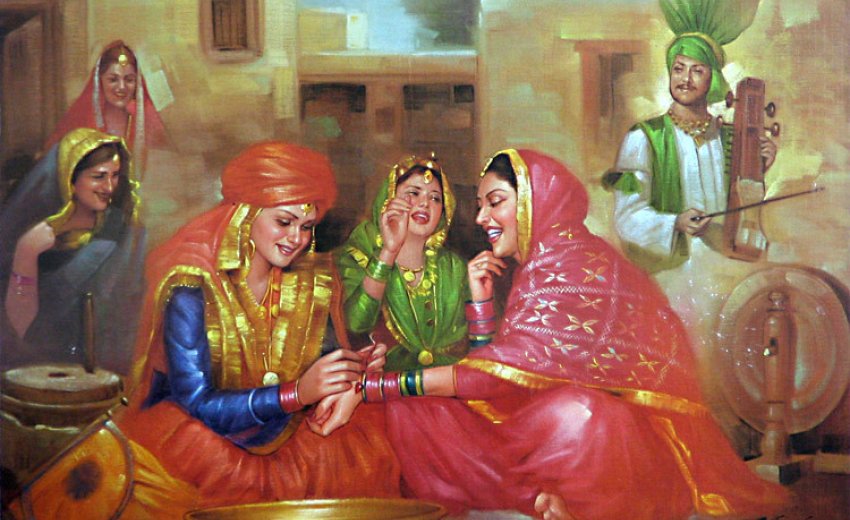Anand Karaj in the 1900s
Recently the Sikh marriage ceremony (Anand Karaj) has come under dispute when concerning couples professing different faiths, which has led to some controversy and conflict. Without going into too much detail of the recent events in the UK, where members of the Sikh community prevented an interfaith marriage from taking place in a Gurdwara, the Akal Takht, the spiritual abode of authority for Sikhs, has made it very transparent in the Sikh Rehat Maryada (Sikh Code of Conduct) that the Anand Karaj ceremony is only permitted for those professing the Sikh faith. And quite rightly so! If one does not wish to accept or practice the Sikh faith, then why would one want a Sikh marriage ceremony? What is intended to be a blissful union of two souls merely becomes a meaningless and ritualistic ceremony.
For many years after the reign of Maharaja Ranjit Singh, the Sikh marriage rites became disoriented with conflicting practices, to the extent where a number of Sikhs were partaking in Hindu Vedic ceremonies to solemnise their marriage. In order to safeguard the sanctity of the Anand Karaj, a Sikh marriage act was officially passed in 1909, which established a legal binding of two people professing the Sikh faith.

This led me to go back to something my maternal grandmother mentioned regarding how Sikh marriages were performed in the early 1900s. It was a common practice for all marriages to be arranged and for girls, as young as seven years old to be engaged (my grandmother was nine years old!). Despite being engaged at such a young age, the girls would legally get married at 15 or 16 and for couples to meet for the very first time on their actual wedding day. My grandparents had a very simple, traditional Sikh wedding ceremony, which took place around the late 1920s-early 1930s (the exact year was never documented). My grandmother very interestingly pointed out, in order for the Anand Karaj to take place, the man had to take Amrit before the ceremony to profess his commitment to the Sikh faith and making a promise that he will maintain Sikh practices within his household. It was not necessary for women to take Amrit before marriage, which was something I could not quite completely understand nor could my grandmother explain why. Upon my grandfather taking Amrit, my grandparent's marriage was sanctified by the Anand Karaj ceremony. The wedding ceremony took place in the ambrosial hours of the morning at around 4-5am, which was a practice that was maintained and continued from the times of the Sikh Gurus. Sadly this practice has now been lost.
This prompted me to question my grandmother further; what if my grandfather did not choose to take Amrit or what if my grandfather had shorn hair but was born in a Sikh household, would they still be allowed to have an Anand Karaj ceremony?
My grandmother made a very bold statement that no Sikh during the British Raj cut their hair; the Sikh identity was strongly intact. The cutting of the Kes became more apparent when Sikhs began to emigrate to the West in the 1950s and 60s, where they faced a backlash of discrimination and hostility towards them. For those who did not take Amrit before their marriage or where a Sikh daughter's hand was given away in marriage into a Hindu household, the Anand Karaj ceremony was not permitted. As an alternative, the couple were offered an opportunity to sanctify their married life and seek the blessings from the Guru in the Gurdwara, where a Sukhmani Sahib or some other form of prayer and an Ardas were performed.
Based upon my grandmother's insight into Sikh marriages in the early 1900s, it is clearly evident that the Anand Karaj ceremony was led and performed for those professing the Sikh faith. Although there was a significant requirement for the male spouse to take Amrit before the marriage, this is not the case now as many Sikh marriages take place with or without either couple being Amritdhari.
Inevitably, interfaith marriages will take place. Civil Service ceremonies are held inside many Sikh Gurdwaras around the world in the presence of Sri Guru Granth Sahib Ji. If a couple wishes to have a marriage ceremony conducted inside a Gurdwara and seek the blessings from the Guru, then we should be able to offer them an alternative ceremony through a prayer and an Ardas.
In spite of the times changing, Sikhs have and should continually maintain the sanctity of the Anand Karaj ceremony between two Sikhs, however to also offer an alternative solution for interfaith marriages.
